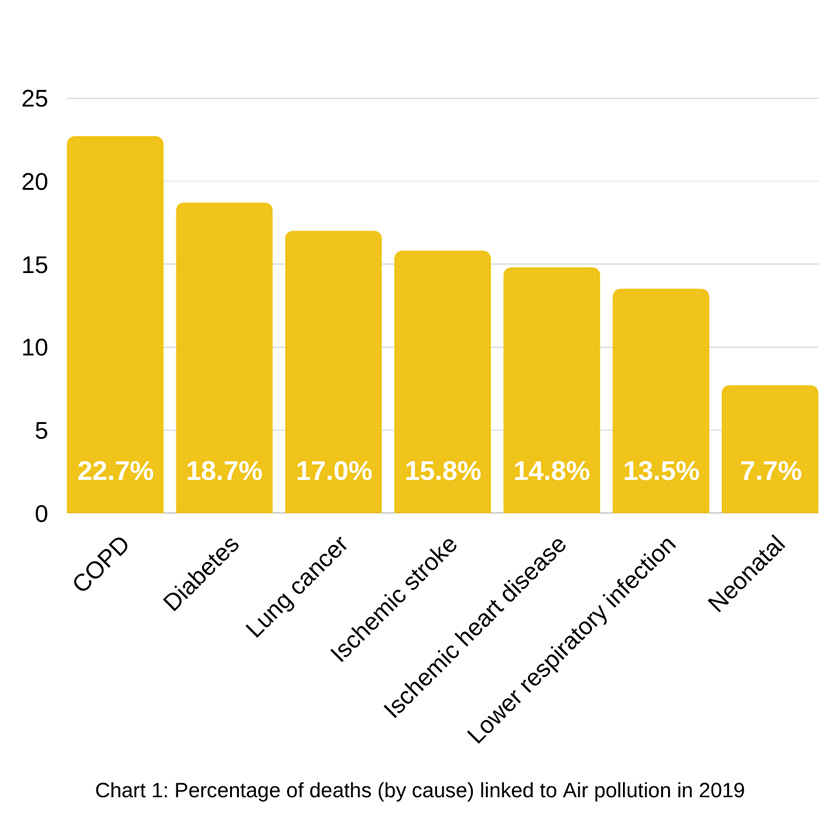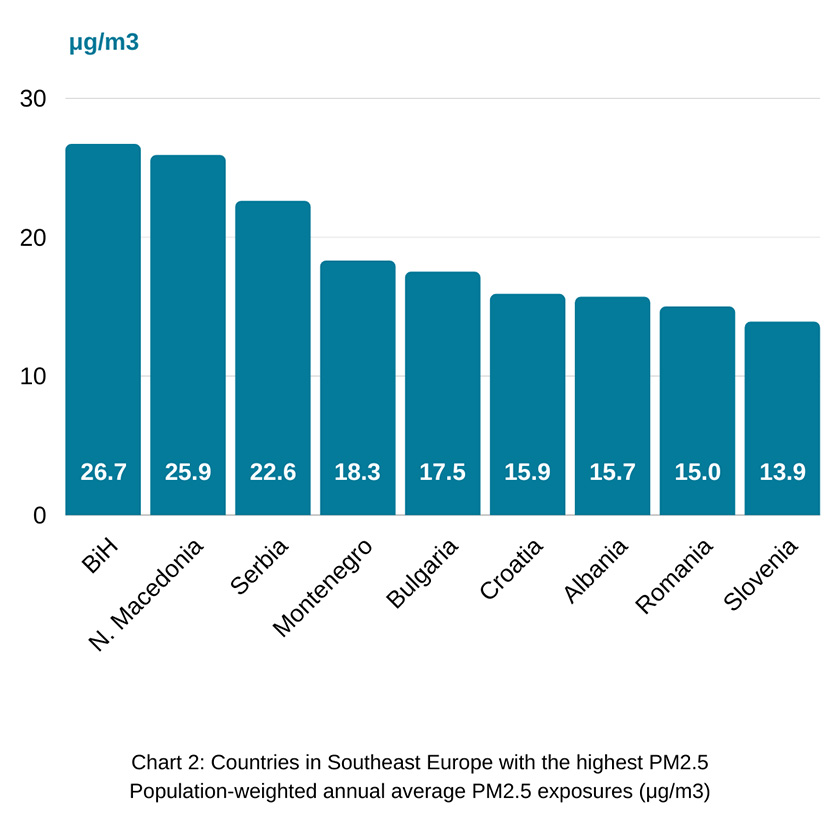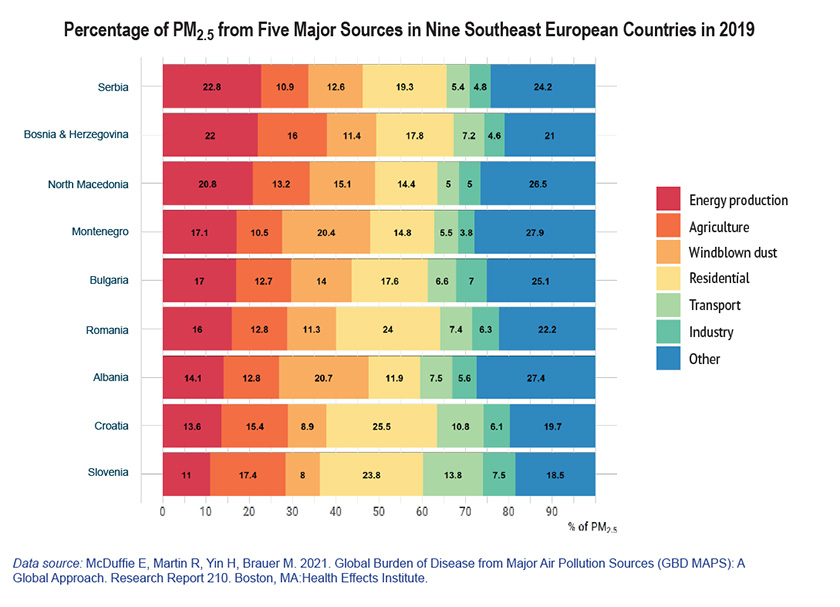
Photo: iStock
Air pollution continues to be a leading health concern in Southeast Europe, where PM2.5 concentrations are well above the World Health Organization (WHO) annual guideline value of 5 μg/m3. This is highlighted in the new report created by the Health Effects Institute.
Up to 99% of the population in this region lives in areas above the WHO annual guideline value of 5 μg/m3 for PM2.5.
According to the analysis “A state of Global Air special report: Trends in Air Quality and Health in SouthEast Europe” published by the Health Effects Institute (HEI), air pollution is ranked among the top 10 risk factors for ill health in every country in Southeast Europe.
Almost 12 percent of total deaths in Southeast Europe (56,300 premature deaths) were linked to air pollution in 2019
Almost 12 percent of total deaths in Southeast Europe (56,300 premature deaths) were linked to air pollution in 2019. Outdoor PM2.5 accounted for the most air pollution-related deaths (46,600, or 9.7% of the total). Romania had the highest number of air pollution–attributable deaths (17,100) in the region while Montenegro had the lowest (700).
Long-term exposures to air pollution contribute to an increased risk of illness and premature death from chronic noncommunicable diseases, such as ischemic heart disease, lung cancer, chronic obstructive pulmonary disease (COPD), stroke, and type 2 diabetes as well as lower respiratory infections (e.g., pneumonia), especially in children under 5 years of age.
Exposure to PM2.5 also puts mothers at risk of delivering babies too early
Exposure to PM2.5 also puts mothers at risk of delivering babies too early and smaller than average, and these babies are more susceptible to dying from a range of diseases or are considered to be at increased risk for diseases later in life. There is also emerging evidence on the role of air pollution in cognitive disorders, including dementia.
PM2.5-linked death rates exceed the global rate of 53.5 deaths per 100,000 population in eight out of nine countries — Slovenia is the only exception
On average, nearly 23% of all COPD-related deaths were attributed to air pollution. The largest impacts were seen in Bosnia and Herzegovina (30%), North Macedonia, and Montenegro (each 26%), while the lowest such burden was estimated for Romania (14%). These numbers come from global atmospheric modeling and are to some extent relying on the data from the monitoring stations in the countries, but might not represent exact real-world monitoring data.
Srdjan Kukolj, Consultant for the Balkan region at the Health and Environment Alliance (HEAL) highlights that Western Balkan countries are very much dependent on fossil fuels.
“We see that extreme levels of air pollution are still present in the region so we call on decision-makers to put health at the center of environmental policies and to set more ambitious plans towards healthier and sustainable ways of living. The link between the damaging effects of poor air quality and humans is very well established. Air pollution threatens human lives in two primary ways: causing an increase in non-communicable disease cases and leading to premature deaths. Not only does it affect people’s lives, but it also contributes to the downfall of public health, the economy, the environment and makes the climate more extreme,’’ Kukolj elaborated.

How have pollutant exposures changed between 2010 and 2019
PM2.5 annual average exposures have decreased for every country in the region over the last decade, with the largest decrease in Serbia, where levels of PM2.5 in 2019 were 19.1% lower compared to 2010.
The highest annual average PM2.5 exposure in 2019 was observed in North Macedonia (30.3 μg/m3), while Romania had the lowest exposure (15.7 μg/m3).

PM2.5 (presented as population-weighted annual average concentration) has been lower in 2019 (19.1 μg/m³) than in 2010 (25.5 μg/m³) but still higher than the EU-28 average (11.4 μg/m³). Household air pollution (percentage of the population relying on solid fuels for cooking) is lower in 2019 (23.0%) than in 2010 (27.7%). Ozone (presented as poulation-weighted seasonal average concentration) has been lower in 2019 (82.0 μg/m³) than in 2010 (87.9 μg/m³), and lower than the EU-28 average (83.5 μg/m³).
Highest impacts of air pollution on the young and the old
Across Southeast Europe, the largest number of deaths occur in people aged 70 or older. Exposure to air pollution accounted for 7.7% of neonatal deaths, with most premature deaths attributed to ambient PM2.5. The percentage of neonatal deaths linked to air pollution in 2019 was largest in Bosnia and Herzegovina (11%) and North Macedonia (10%).
Key sources of PM2.5 in Southeast Europe
Important fuel contributors to PM2.5 exposures in the region include coal, liquid fuel and natural gas, and solid biofuels. As individual sources, residential sources contributed the most (20%) to PM2.5 attributable deaths in 2019, followed by energy production (18%), windblown dust (13%), agriculture (13%), and transport (7%).
Vlatka Matković, Senior Policy Officer at the Health and Environment Alliance (HEAL) has raised concerns about the long-term exposure to air pollution across the region: “Europe’s South-Eastern region has long been an air pollution hotspot, with coal-burning as the main contributor. This report confirms the urgency to act for clean air for health. A swift phase-out of the region’s chronic coal pollution is needed to protect health and help tackle climate change. Ending coal dependence will bring many benefits, including reduced rates of cancer, heart and lung disease, and the healthier development of children.”

Chart 3 : Sources of PM2.5 pollution in nine Southeast European countries in 2019, in % from total PM2.5 pollution
Strengthened political commitment and efforts overdue
Establishing cooperation between the countries of the Western Balkans should lead to strengthening the health response toward stopping pollution, experts underline. They are united in the opinion that ministries of health, public health institutes, and academia must play a more participatory role in decision-making relevant to public health, energy, climate change, and the environment.
Regional cooperation is essential to achieving a healthier and more sustainable future. Leading organizations in the field of air pollution and its impact on health recommend to the leaders of this region to urgently move away from polluting practices, especially from burning fossil fuels and commit to integrated, effective measures that will lead to a significant reduction in the health burden due to air pollution in the region, which has so far left an unacceptably large burden for public health, the environment and economy.


















Be the first one to comment on this article.